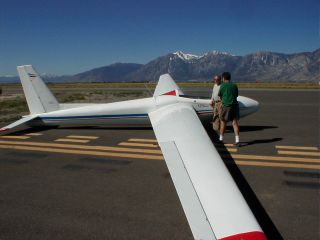Soaring at Lake Tahoe
We were planning a vacation to Lake Tahoe. It was our first trip there so we naturally asked around for ideas on things to do. Knowing I was a pilot, many friends recommended taking a glider ride from Soar Minden located at the Minden, Nevada airport (KMEV). The area is supposed to be ideal for soaring and Soar Minden has an excellent reputation.
As luck would have it, our rental condominium was on a ridge at Heavenly ski area. Our east-facing windows looked out over the Carson Valley. At night, the view treated my eyes to the alternating green-white blink of an airport beacon in the valley below. Minden-Tahoe Airport! How could I possibly resist?
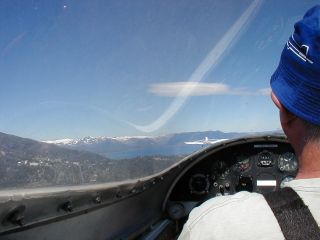
We made arrangements for the Emerald Bay Excursion Flight, billed by Soar Minden as an hour flight over Lake Tahoe. Arriving at the airport for the flight, we were introduced to our pilot, John Hannon, an FAA retiree whose love of flying was apparent from the first moment. On the way out to the glider “ready” area, John briefed us on the flight. Once there, we were introduced to our craft, a Schweizer SGS 2-32 3-place glider and strapped into place. A wiggle of out rudder to let the tow plane pilot know we were ready, and off we went!
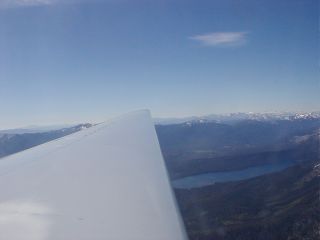
What a fabulous ride! We were towed out to Lake Tahoe’s famous Emerald Bay. Reaching it, John released the tow rope and we banked right as our tow place banked left. Our route back home took us over the bay, Fallen Leaf Lake, across Lake Tahoe and back to the ridge that separates Lake Tahoe from Carson Valley. We played along the ridge for a while, John treating us to the fun of ridge soaring – a maneuver in which the glider flies very close to the ridge, using the updraft from the windward side to generate lift. We were also treated to a, let’s say, interesting view of our condominium.
Returning to the airport with a perfect landing, we left intoxicated with the joy of the flight. In fact, I was intoxicated enough that I just had to sign up for a lesson and try my hand at flying with no engine.
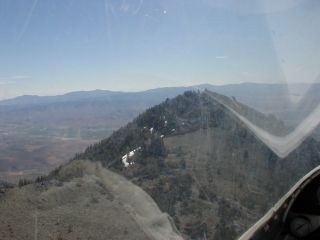
I returned two days later for my lesson, with John as my instructor. John gave me the short version of a ground course as we headed out to the staging area for me to meet the Grob 103 Acro II we would use for my lesson. This was a well-equipped glider with on-board oxygen. These aircraft have pretty goo altitude capability. The record at Soar Minden is held by a Japanese visitor who soared to 37,400 feet above sea level.
I was told that as a CFI in powered aircraft, I shouldn’t have too much of a problem with the glider. Fortunately, I had heard that story before and knew better. The Grob was much less stable and had far more adverse yaw1 than anything I had flown before. On top of that, probably because of the amount of adverse yaw the ailerons produced, the rudder deflected further and required far more pressure than I was used to.
With John coaching (and laughing at my continuous errors) we took off. There are a number of methods of being towed. We were to use a method in which we remain above the tow plane’s wake and mirror it’s movements. I “decided” it would be much more fun to jerk the tow plane left and right and up and down, leaving the poor tow pilot in calm air for only seconds at a time and confused about out intentions (I’m told pulling the tow plane’s tail is a signal for the tow plane to head in a different direction). Sigh. John made it look soooo easy.
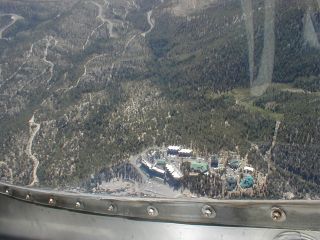
Once released, the object of the game is to find a thermal – a column of rising air – and stay in it by circling. I did the best I could, but between the adverse yaw, the heavier rudder pressure required, and the “yaw string” giving me a prompt opposite to the one I’m used to from a turn coordinator in an aiprlane (“pull the string!”), I was either not leading enough with rudder, leading too much with rudder, adding rudder in the wrong direction, or finding some other interesting (although I am told not unique) method of uncoordinated flight 98% of the time. The other 2% – a few coordinated turns during which I managed to reamin in a colum of rising air – were sheer luck. I had no idea what I was doing, but was unduly pleased with the result.
It really was great fun and John was a wonderful instructor. There are many basic skills and aerodynamic principles common to powered and unpowered flight. There are especially similarities in the knowledge needed when flying near and around mountainous terrain. But there are additional procedures and techniques that take learning when making the change from powered flight to gliders. I probably will remain a confirmed power pilot, but will be drawn back to soaring again and again for the quiet, the beauty, and the chance to better my flying skills.
Many thanks to John Hannon and all the people at Soar Minden for a wonderful experience!
To see more photos of this flight, click here.
1. Adverse yaw is a tendency of an airplane or glider to yaw in the opposite direction of a turn. It is a byproduct of the use of ailerons. Deflect the ailerons for a left turn and the aircraft yaws right. Aircraft rudders are used to counteract this aerodynamic reality. Return to story.
